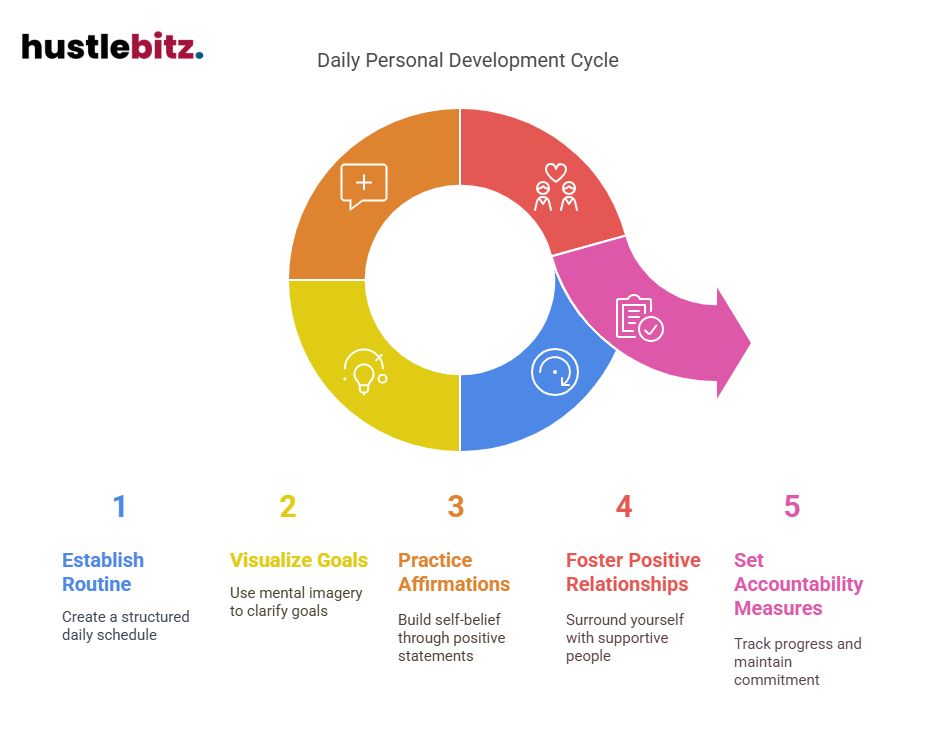Effective self-motivation techniques are crucial for staying on track. Begin by establishing a routine that fosters consistency and productivity. Visualization techniques, including vision boards, can enhance your focus on goals. Positive affirmations nurture self-belief and cultivate a constructive mindset. Surrounding yourself with uplifting environments and people amplifies motivation. Embracing failure as an opportunity for growth encourages resilience. Additionally, staying accountable through partners or community support can significantly enhance commitment to your objectives. By integrating these strategies into your daily life, you can elevate your self-motivation and achieve your aspirations. Discover further insights to enhance your journey.
Key Takeaways
- Establish a daily routine that includes morning rituals and evening reflections to enhance consistency and productivity.
- Use visualization techniques, such as vision boards and mental imagery, to clarify and motivate your goals.
- Practice positive affirmations daily to build self-belief and counteract negativity.
- Surround yourself with uplifting relationships and positive environments to foster motivation and emotional support.
- Set accountability measures, like commitment contracts and daily check-ins, to track progress and maintain commitment to your goals.

Develop a Routine

Establishing a consistent routine is fundamental to enhancing self-motivation and fostering productive habits. A well-structured daily routine can significantly improve focus and efficiency.
One effective approach to creating a routine involves implementing morning rituals that set a positive tone for the day. Engaging in activities such as meditation, exercise, or reading can energize you and prepare your mind for the tasks ahead.
Evening reflections are equally important, allowing individuals to assess their day, identify achievements, and plan for the following day. This practice not only promotes self-awareness but also aids in goal setting, ensuring that priorities are clear.
Time blocking can further enhance this process by allocating specific periods for various tasks, enabling effective priority management. Incorporating habit stacking—linking new habits to established ones—can facilitate the development of positive routines.
Implementing reward systems, where you treat yourself upon completing tasks, reinforces motivation and makes the process enjoyable. Additionally, flexibility training within your routine allows for adjustments as unforeseen circumstances arise, ensuring that you remain on track without feeling overwhelmed.
To maximize productivity, distraction minimization and environment optimization are crucial. Creating a workspace free of distractions and tailored to your needs can enhance focus and efficiency.
Visualize Your Success

Building on the foundation of a structured routine, visualizing your success can serve as a powerful tool to enhance motivation and clarity in achieving your goals. By employing techniques such as achievement visualization and mental imagery, you can create a vivid picture of your future self, which helps in goal setting and fosters an emotional connection to your aspirations. This practice not only enhances sensory engagement but also serves as a daily reminder of what you are working towards.
To implement visualization effectively, consider incorporating elements like vision boards and success journaling. These tools allow you to document your goals visually and textually, reinforcing your commitment. Additionally, motivational quotes can serve as inspiration, anchoring your vision in a positive mindset.
Here’s a table to summarize effective visualization techniques:
| Technique | Description |
| Goal Setting | Define clear, achievable objectives. |
| Mental Imagery | Create detailed mental pictures of success. |
| Success Journaling | Write reflections on your progress and feelings. |
| Vision Boards | Assemble images and words that inspire you. |
| Daily Reminders | Use quotes and affirmations to stay focused. |
Use Positive Affirmations
Utilizing positive affirmations can significantly enhance self-belief and motivation by reinforcing a constructive mindset and encouraging a proactive approach toward achieving personal goals. These affirmations serve as powerful self-talk strategies, fostering a positive internal dialogue that can transform one’s belief systems. By incorporating affirmation techniques into daily routines, individuals can create daily mantras that resonate with their aspirations and values.
The practice of positive reinforcement through empowering phrases aids in developing mindset shifts essential for personal growth. For instance, repeating affirmations such as “I am capable of achieving my goals” can instill resilience and determination. This continuous self-encouragement not only boosts confidence but also plays a crucial role in emotional regulation, helping individuals navigate challenges with a more optimistic outlook.
Moreover, the regular use of positive affirmations fosters an environment conducive to confidence boosting. By consciously choosing empowering phrases, individuals can counteract negative thoughts that may hinder progress. This intentional focus on uplifting messages supports a healthier internal dialogue, which is vital for maintaining motivation over time.
Surround Yourself With Positivity

Creating an environment filled with positivity is essential for fostering self-motivation and enhancing overall well-being. The spaces we inhabit and the relationships we cultivate significantly influence our mindset. By surrounding ourselves with positive environments, we can elevate our motivation and encourage productive behaviors. Uplifting relationships play a crucial role in this process, as they provide emotional support and inspiration, helping us to remain focused on our goals.
To create effective motivational spaces, consider integrating elements that inspire and energize you. This might include engaging in energizing activities, such as exercise or creative pursuits, which can invigorate your spirit. Joining supportive communities, whether online or in-person, fosters a sense of belonging, allowing you to share experiences and strategies with like-minded individuals.
In addition, surrounding yourself with inspiring media—books, podcasts, and videos that promote positivity—can reinforce an optimistic outlook. Engaging with encouraging mentors can also provide guidance and motivation, helping you navigate challenges with a constructive mindset. Utilizing optimistic language in daily interactions and self-talk is another powerful tool for maintaining a positive perspective.
Incorporating gratitude practices into your routine can further enhance positivity. By acknowledging and appreciating the joyful experiences in your life, you can shift your focus away from negativity.
Ultimately, cultivating a positive environment, filled with uplifting relationships and enriching experiences, is vital for sustaining self-motivation and achieving personal growth.
Embrace Failure as Growth
An environment filled with positivity not only enhances motivation but also prepares individuals to view failure as an opportunity for growth and learning. Embracing a failure mindset is crucial for personal growth, as it encourages individuals to perceive setbacks not as insurmountable obstacles, but as valuable learning experiences. By adopting this perspective, one can cultivate resilience and develop adaptive strategies to navigate future challenges.
To effectively embrace failure as a catalyst for growth, consider the following strategies:
- Embrace Challenges: Actively seek out challenges that push your boundaries. Risk taking can lead to significant learning experiences, fostering a deeper understanding of your capabilities.
- Seek Constructive Feedback: Gathering insights from others can illuminate areas for improvement. Constructive feedback provides a roadmap for overcoming obstacles, transforming perceived failures into opportunities for further development.
- Implement Mindset Shifts: Transition from a fixed mindset to a growth mindset. This shift allows individuals to view failures as stepping stones rather than dead ends, promoting ongoing personal growth and resilience building.
Stay Accountable

Staying accountable is essential for maintaining motivation and ensuring progress toward personal and professional goals. By implementing structured methods for accountability, individuals can enhance their commitment to goal setting while tracking their progress effectively.
One effective strategy is to establish accountability partners, who can provide support and encouragement. Additionally, commitment contracts can be created to formalize one’s dedication to specific objectives. Regular feedback loops foster communication and allow for necessary adjustments along the journey.
To visualize the strategies for staying accountable, consider the following table:
| Accountability Technique | Description |
| Daily Check-Ins | Brief assessments of progress and challenges faced. |
| Social Sharing | Sharing goals with a community to foster support. |
| Milestone Celebrations | Recognizing and celebrating small victories to maintain motivation. |
| Self Reflection Sessions | Regularly assessing personal growth and areas for improvement. |
Incorporating these techniques can significantly enhance one’s ability to remain accountable. Reward systems can also play a vital role; by rewarding oneself after achieving specific milestones, motivation is sustained. Furthermore, feedback from accountability partners can stimulate personal growth and create a cycle of continuous improvement.
Final Thoughts
Staying motivated is a continuous journey that requires intentional strategies to maintain focus and commitment. By developing a consistent routine, practicing visualization, and utilizing positive affirmations, you can foster a mindset that is driven and goal-oriented. Surrounding yourself with a positive environment and uplifting relationships will support your efforts and provide encouragement when challenges arise. Embracing failure as a learning opportunity builds resilience, while staying accountable ensures progress and keeps you on track. Incorporating these techniques into your daily life will enhance your self-motivation, helping you achieve both personal and professional goals with clarity and confidence.




